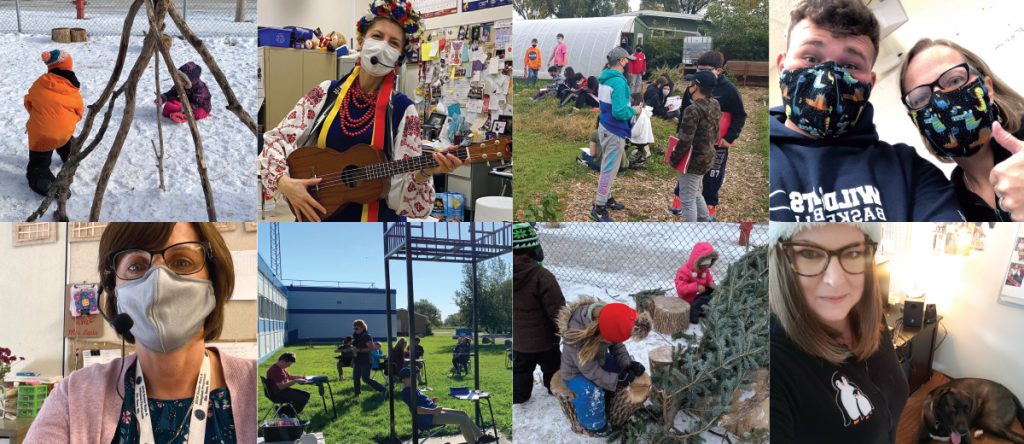
Picture 2020. What Do You See?
Manitoba’s public school teachers saw students. They saw them in class and online. Indoors and out. They created safe spaces for learning and built connection any way they could.
Last spring, COVID-19 forced the province to postpone the release of its K-12 Education Commission report. Now the time has come to move forward.
On February 1, MTS launched “Picture this: My classroom. Our future.” an awareness campaign calling for the report’s release, and for dialogue about what’s good for kids in classrooms.
In 2019, The Manitoba Teachers’ Society put forward 17 recommendations for change, read them here. And together, let’s picture public education in 2021 and beyond.
See our print ads here: 1 | 2 | 3
Picture this: My classroom. Our future. Radio Ad
This is our radio advertisement featuring MTS President James Bedford.
Education Review Must Consider Pandemic’s Impacts
Winnipeg Free Press, February 3, 2021
The saying goes, “Life is what happens while we make other plans.” In the wake of 2020, there can be no doubt that even the sturdiest of plans and noblest of intentions are subject to the forces of bigger, unforeseen agendas.
Take for example the planned release of the Manitoba Government’s K-12 Education Commission report, slated for early spring of last year. The novel coronavirus had other plans, raging into Manitoba and putting everything, from spring break trips to highly anticipated government report releases, abruptly and indefinitely on hold.
Now, almost a year into what has become our abnormal normal, we are finding our way back to some of those long-abandoned, pre-COVID plans. And so it is with the report of the commission.
Former Education Minister Kelvin Goertzen signaled his intent to release the delayed report relatively early in 2021, and there has been no news to the contrary from newly minted Education Minister Cliff Cullen. To him falls the task of ushering in what is purported to be the most significant change to the province’s public education system in more than a generation.
While we await the report and do what we can to prepare, I’m reminded of the work of our teachers and teacher leaders who, over the past year, through sheer determination and dedication to our children, kept educating. They did it in classrooms, they did it on Zoom and Kahoot and Seesaw. They did it door-to-door, dropping off packages for kids whose access to the internet was spotty or non-existent. They ventured online, forging new connections with students and families. They sang songs, played math games, did yoga, produced TikTok videos, performed music and created art. They kept us physically active. They did not let us down.
This extraordinary effort came at a price, however. Many of our public school teachers, some 16,600 in Manitoba, were bent to the point of breaking. On not much more than a moment’s notice, they reinvented lessons and redesigned classrooms, often moving onto playgrounds or virtual space. They gave up summer vacations to prepare and in September ricocheted between two and three classrooms at a time to accommodate physical distancing. They simultaneously taught in person and online and covered for one another while substitutes were in short supply, even as additional teachers were hired. And they labored under the weight of their own expectations, often holding themselves to a pre-pandemic standard of educating and supporting students. They have been challenged. And they have persevered.
This is our reality, this is where we are as we await news of how the landscape of public education, so warped by the specter of COVID-19, will be reinvented.
Make no mistake, teachers—and their union—have welcomed and supported the work of the commission from the start. Commissioners met with MTS as they began their work, and MTS followed up with a written submission identifying eight areas for improvement and 17 recommendations for change.
We do not yet know the substance of the commission’s recommendations, but we know one thing for sure—they’ll cost money.
Chronic underfunding has plagued our public education system since this government took office. Supposed “increases” have kept pace with neither the rate of inflation nor enrolment growth, putting increased pressure on school divisions, teachers and others to do more and more with less and less.
There is more going on in our classrooms than meets the eye, as poverty and inequity stymie potential, limit graduation rates and inflate reliance on costly healthcare services and social programs. In its December, 2020 report Manitoba: Poverty Central, The Social Planning Council of Winnipeg found that in 2018, 87,730 Manitoba children lived in poverty, up from 85,450 in 2017. One can only imagine the pandemic’s horrific impact. To merely tinker with curriculum and ignore fundamental social and economic cancers is to doom any attempt at academic improvement.
Children are in need of more support, not less. Among other things, they need more teachers so class sizes are reasonable, access to food programs so they can concentrate, and an increase in clinicians to identify and address obstacles to learning as early and thoroughly as possible.
Yes, life is what happens while we make other plans. But plan we must. There will be challenges as we prepare to evolve our public education system, and teachers are, as always, ready to roll up their sleeves.
Still, if we are to witness meaningful improvement inside the classroom, we must first acknowledge and address our children’s reality outside of it.
– James Bedford is president of The Manitoba Teachers’ Society
